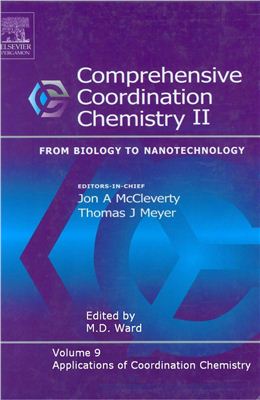10-Volume Set – Hardbound: Elsevier: Amsterdam. 2003. - 9500
pages
Volume 1: Fundamentals: Ligands, Complexes, Synthesis, Purification, and Structure - Lever A.B.P. (ed. )
Volume 2: Fundamentals: Physical Methods, Theoretical Analysis, and Case Studies - Lever A.B.P. (ed. )
Volume 3: Coordination Chemistry of the s, p, and f Metals – G.F.R. Parkin (ed. )
Volume 4: Transition Metal Groups 3–6 – A.G. Wedd (ed. )
Volume 5: Transition Metal Groups 7 and 8 – E.C. Constable, J.R. Dilworth (ed. )
Volume 6: Transition Metal Groups 9–12 – D.E. Fenton (ed. )
Volume 7: From the Molecular to the Nanoscale: Synthesis, Structure, and Properties – M. Fujita, A. Powell, C. Creutz (ed. )
Volume 8: Bio-coordination Chemistry – L. Que, Jr. , B. Tolman (ed. )
Volume 9: Applications of Coordination Chemistry – M.D. Ward (ed. )
Volume 10: Cumulative Subject Index
This volume aims to give as complete a coverage of the real and possible applications of coordination complexes as is possible in a single volume. It is far more wide-ranging in its coverage than the related volume on ‘applications’ in the first edition of CCC (1987). The chapters cover the following areas: (i) use of coordination complexes in all types of catalysis (Chapters 1–11); (ii) applications related to the optical properties of coordination complexes, which covers fields as diverse as solar cells, nonlinear optics, display devices, pigments and dyes, and optical data storage (Chapters 12–16); (iii) hydrometallurgical extraction (Chapter 17); (iv) medicinal and biomedical applications of coordination complexes, including both imaging and therapy (Chapters 18–22); and (v) use of coordination complexes as precursors to semiconductor films and nanoparticles (Chapter 23). As such, the material in this volume ranges from solid-state physics to biochemistry.
Volume 1: Fundamentals: Ligands, Complexes, Synthesis, Purification, and Structure - Lever A.B.P. (ed. )
Volume 2: Fundamentals: Physical Methods, Theoretical Analysis, and Case Studies - Lever A.B.P. (ed. )
Volume 3: Coordination Chemistry of the s, p, and f Metals – G.F.R. Parkin (ed. )
Volume 4: Transition Metal Groups 3–6 – A.G. Wedd (ed. )
Volume 5: Transition Metal Groups 7 and 8 – E.C. Constable, J.R. Dilworth (ed. )
Volume 6: Transition Metal Groups 9–12 – D.E. Fenton (ed. )
Volume 7: From the Molecular to the Nanoscale: Synthesis, Structure, and Properties – M. Fujita, A. Powell, C. Creutz (ed. )
Volume 8: Bio-coordination Chemistry – L. Que, Jr. , B. Tolman (ed. )
Volume 9: Applications of Coordination Chemistry – M.D. Ward (ed. )
Volume 10: Cumulative Subject Index
This volume aims to give as complete a coverage of the real and possible applications of coordination complexes as is possible in a single volume. It is far more wide-ranging in its coverage than the related volume on ‘applications’ in the first edition of CCC (1987). The chapters cover the following areas: (i) use of coordination complexes in all types of catalysis (Chapters 1–11); (ii) applications related to the optical properties of coordination complexes, which covers fields as diverse as solar cells, nonlinear optics, display devices, pigments and dyes, and optical data storage (Chapters 12–16); (iii) hydrometallurgical extraction (Chapter 17); (iv) medicinal and biomedical applications of coordination complexes, including both imaging and therapy (Chapters 18–22); and (v) use of coordination complexes as precursors to semiconductor films and nanoparticles (Chapter 23). As such, the material in this volume ranges from solid-state physics to biochemistry.

